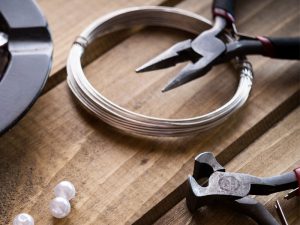Top 7 Essential Tools For Wire Wrapping
Wire wrapping is a great creative technique when it comes to jewellery making. From wrapping beads and crystals to add extra detail, to forming ear wires and other unique jewellery shapes, there are plenty of ways to use this method. But before you get started, you need to know what the essential tools for wire wrapping are – and how to use them.
What we love about this technique is that it only really requires a few tools, meaning anyone can give it a go. And it’s an inexpensive route into jewellery making, perfect for trying your hand at before moving on and advancing to other technical processes. Find out more about the jewellery wire wrapping tools you need to help get you started below.
What jewellery wire wrapping tools do I need?
While jewellers might argue that there are multiple wire wrapping tools that are all indispensable, there are a certain few wire wrapping tools that are absolutely necessary. That’s why we’ve outlined the top seven wire wrapping tools for beginners to get you on your journey to becoming a jewellery making master. From wire wrapping pliers to cutters and files, discover how to complete your wire wrapping kit below.
1. Pliers
One of the most important tools for wire wrapping. A jeweller can never have too many pliers when it comes to wire wrapping – and the choices are endless. Each style produces different curves, shapes and effects, and each jeweller has their own preference. But here are some wire wrapping pliers we recommend to help get you started:
- Round nose pliers: one of the most common types of jewellery pliers, round nose pliers can smoothly bend wire to help make loops, jump rings and other jewellery findings, as well as making small diameter turns.
- Flat nose pliers: featuring flat facing jaws that are perfect for manipulating sheet metal and wire.
- Half round pliers: featuring one flat jaw and one half-round jaw – making them ideal for creating rings and shaping wire.
- Chain nose pliers: with rounded outsides and flat facing jaws, tapering to a small point making them ideal for wrapping wire and closing jump rings.
Check out the full range of jewellery pliers at Cooksongold, with options suitable for looping, bending, cutting and so much more.
2. Cutters
When wire wrapping jewellery, you need to cut the wire flush – and a pair of scissors or a kitchen knife just won’t cut it. So you’ll need a quality pair of wire cutters. They’re also handy for cutting down the wire and getting it to the size you need. Available in a range of sizes and styles, our selection of cutters are ideal for wire, sheet metal and pieces of solder.
3. Hammers
Jewellery hammers allow you to shape the wire, work-harden it and flatten it – which makes them one of the most vital wire wrapping supplies. And you can never have too many! We’ve outlined some of the most popular hammers for wire wrapping below:
- Jewellers’ hammer: perfect for a range of jewellery making projects. A jewellers’ hammer is also ideal for work-hardening the wire to make it more durable.
- Rawhide hammer: used to strengthen your base frame wire and it can help flatten your wire and return it back into shape if you’ve made a mistake.
- Repousse hammer: ideal for adding texture to your metal and wire, as well as flattening it.
4. A rule
Working on a small, intricate design? Need to get an exact measurement for your wire? Then you’ll need a ruler. This is a handy piece of equipment to have in your workshop, as you’ll need one for a range of projects.
5. A mandrel or triblet
Two of the most popular tools for wire wrapping if you’re looking to make a ring. Triblets and mandrels can be used to form or re-shape metal, and come in a range of shapes and sizes.
You can also use them to form rings or circular bezels into specific sizes, to re-size an existing ring or to correct the shape of a design. What’s more, a bracelet mandrel can help you produce your own bespoke bangles. Staples in any wire wrapping kit, browse a wide range of triblets and mandrels at Cooksongold today.
6. Files and sandpaper
This is a piece of the wire wrapping kit that you just can’t miss, because when you’re cutting wire, you’re going to be left with sharp edges – which aren’t ideal when it comes to wearing jewellery. That’s why you’ll need a selection of files and sandpaper to help smoothen down the sharp corners to make your designs safe to wear.
7. Wire
All these tools for wire wrapping are useless without the wire itself! When choosing your wire wrapping supplies, it’s important to consider which wire is the right choice for your project. If it’s your first time wire wrapping jewellery, you might want to start with craft, copper or silver-plated wire. As these metals are slightly cheaper, they’ll give you more room to make mistakes and get used to the technique – as you may come across a few breakages along the way! Once you’ve mastered the technique, you can move onto something a little more pricey, like sterling silver or gold. There are also different sizes of wire that are suited to different designs:
- Smaller wires are (around 0.5mm or less) are perfect for wrapping around beads or gemstones to add more detail.
- Medium wires (1mm) can be used to make findings and create unique shapes used for pendants, earrings and more.
- Medium-thick wires (around 2mm) are ideal for forming your own rings and bracelets.
- Thicker wires (e.g. 3-4mm) are harder to work with, but are perfect for bulky, bold designs.
And there you have it – the top seven essential tools for wire wrapping. Find all the wire wrapping tools you need for your next project at Cooksongold, as well as plenty of wire to help bring your designs to life. Browse the selection of bullion and jewellery tools online, and pick up the equipment you need today.
The post Top 7 Essential Tools For Wire Wrapping appeared first on The Bench.
source https://www.cooksongold.com/blog/beginners-guides/top-7-essential-tools-for-wire-wrapping

Comments
Post a Comment